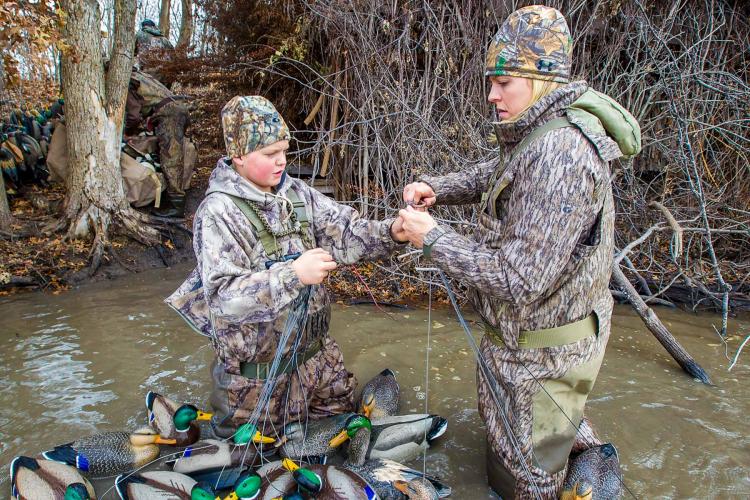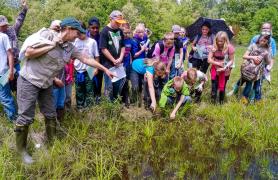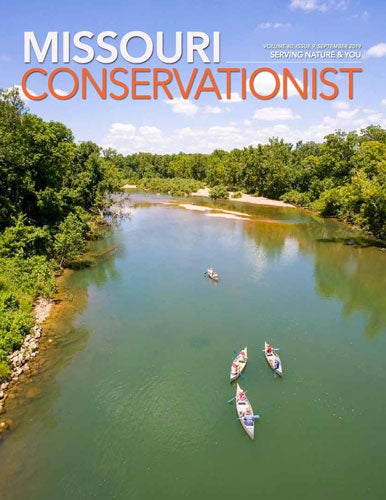Chip Malmstrom ranks the most important things in his life as faith, family, and water fowling, in that order. Bass fishing comes in a very close fourth. Once teal season opens in early September, birds become the focus and passion of the remainder of the year. It’s a chance to unplug from devices, spend time as a family, sit quietly in nature, and simply be.
“It’s great for families because everyone can go along at the same time,” Chip said. “The kids can be loud and fidgety, and they only have to quiet down and get serious when the birds fly in and start working.”
“I like that you can talk and eat while hunting ducks; it’s relaxed,” said Max, his youngest son.
Chip knows hunters who don’t bring their kids to the marshes and wetlands because it can be a lot of work, but he wants his kids to learn how to do it. He can show them when to make the right call.
“I also can take new people and they don’t have to have a lot of specialized gear and camouflage if we are hunting from a blind — just a shotgun and a few decoys,” he said. “With deer hunting, there can be a lot of sitting and waiting, noise and scent discipline, and you might not see anything, which could lead to kids losing interest. With waterfowl hunting, you typically get at least a few chances to harvest a bird even on a bad day.”
The family’s Carroll County property is enrolled in the Wetland Reserve Program and has been in partnership with MDC, Natural Resources Conservation Service, and Ducks Unlimited at various times to ensure good habitat for waterfowl, deer, and other wildlife.
“I manage the marshes for the birds and actively manage the woodlands for deer,” he said. “I love giving kids an opportunity to get in there to harvest their first deer. I have food plots and box blinds at natural choke points; I want to give them a chance to have some success so they don’t lose interest in hunting.”
In the past, he would try to get out in the morning to hunt ducks, then hit the deer woods in the evening, but his attention has turned to spending the afternoons out on the marsh as well. He has found there is less pressure on the birds, and it gives multiple opportunities each day to keep kids and newcomers interested.
Chip also has been keeping data on his hunts for the past several years. The 2018 seasons brought 46 different hunts, 34 of which included youth hunters. They averaged 11.18 birds per hunt, 142 total teal and 110 honkers. Harvest numbers have been going up steadily each year as good management practices start to yield better results. The total harvest for 2018 for the property was exactly 500 birds — the most ever — with four banded geese and the first banded duck.
“I like seeing where they were from and when they migrated,” he says. “Three of the geese were from Minnesota, and a pair were banded on opposite sides of the state on the same day, joined up for the flight south, and were both harvested over the same marsh on the same day several months later.”
He uses a paper calendar to track weather patterns, who was hunting each day, and what species and numbers of birds were harvested. As he flips through calendars from past years, his eyes light up as he remembers days afield and the fun that was had with friends and family. He has also learned from his data that he’s not going to bother hunting on mornings after a full moon because the birds stay up all night feeding and aren’t responsive to calling by the time daylight comes around.
“We adjust every year,” he said. “We see what works and what doesn’t, what modifications to the blind proved effective, how water levels changed our numbers, stuff like that.”
Not every hunter has access to a private wetland, and Chip pointed out that the family has also had good luck hunting on farm ponds using cut cedar branches as a blind. When the wetlands freeze up, they will walk a creek to find pockets of open water for the chance to jump hunt ducks.
“You can find success if you are where the birds want to be,” he said.
While they have a lot of successful days in the field, when the birds just aren’t cooperating, Chip and the boys are just as happy to take a walk in the woods, search for antler sheds, and let the dogs run.
“We just love being in the outdoors,” he said. “A bad duck hunt might turn into a hike or a squirrel hunt.”
Julie Malmstrom, who grew up duck hunting with her dad and older brother, said she enjoys watching the sunrise and how quiet and peaceful it is as the day sinks in. She has particularly liked watching the boys’ progression over the years, from having to do everything for them out on the duck water to watching them make the decisions on setting the decoy spread, giving advice to younger kids, and working the calls. Julie enjoys observing the “chaotic organization” — thousands of ducks and geese on the move — and will invite other moms out to hike or sit in the marsh blind to see a side of nature they may not have ever been exposed to. Waterfowl hunting is an affair best enjoyed by sharing with as many family and friends as possible.




























Also In This Issue


And More...
This Issue's Staff
Editor - Angie Daly Morfeld
Associate Editor - Larry Archer
Staff Writer - Bonnie Chasteen
Staff Writer - Heather Feeler
Staff Writer - Kristie Hilgedick
Staff Writer - Joe Jerek
Art Director - Cliff White
Designer - Les Fortenberry
Designer - Marci Porter
Photographer - Noppadol Paothong
Photographer - David Stonner
Circulation - Laura Scheuler






















